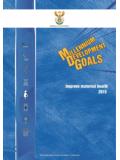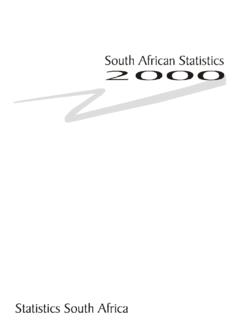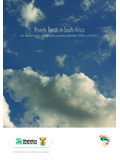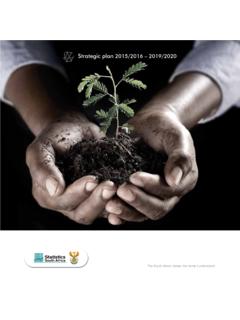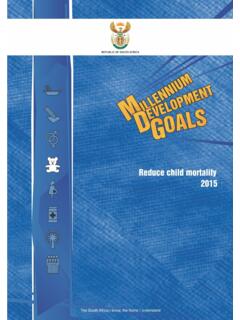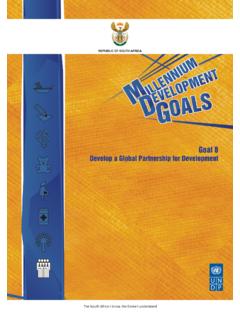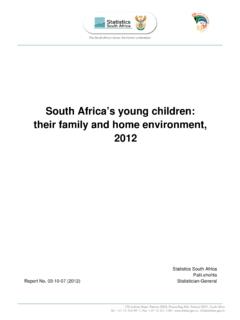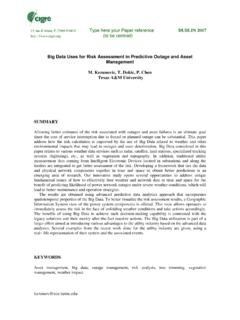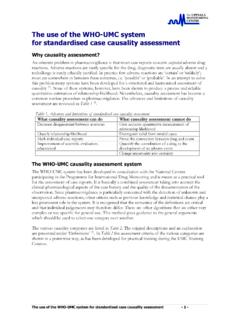Transcription of South African Statistical Quality Assessment Framework ...
1 South African Statistical Quality Assessment Framework (SASQAF)First editionSouth African Statistical Quality Assessment Framework (SASQAF)Pali LehohlaStatistician-GeneralStatistics South Africa2008 First editionPublished by Statistics South Africa, Private Bag X44, Pretoria, 0001 Website Statistics South Africa, 2008No part of this publication may be reproduced in any manner without full acknowledgement of Stats SAStatistics South Africa Library Cataloguing-in-Publication (CIP) DataSouth African Statistical Quality Assessment Framework (SASQAF). 1st ed. / Statistics South Africa - Pretoria: Statistics South Africa, 2008iv, p. 28 ISBN 0- - data Quality - Assessment . South (LCSH 24)A complete set of Stats SA publications is available at the Stats SA Library and the following libraries:National Library of South Africa, Pretoria DivisionNational Library of South Africa, Cape Town DivisionLibrary of Parliament, Cape TownBloemfontein Public LibraryNatal Society Library, PietermaritzburgJohannesburg Public LibraryEastern Cape Library Services, King William's TownCentral Regional Library, PolokwaneCentral Reference Library, NelspruitCentral Reference Collection, KimberleyCentral Reference Library, MmabathoEnquires regarding the content of this manual: data Management and Information Delivery (DMID): (012) 310 8602 National Statistics Systems Division (NSSD): (012) 310 8635 Email: involves contestation, debate and disagreement between contending interests.
2 This is both necessary and healthy. Statistics are often mobilised in support of, or in opposition to, several of these contending interests. This, too, is part of the ordinary lifecycle of any democratic society, especially where statistics are used as a basis for evaluating and measuring the impact of policies, estimating progress in meeting national priorities such as economic growth and job creation, and assessing the success of initiatives aimed at reducing scourges such as crime and of statistics collected in different ways, over time, and for different purposes, is an essential element in assessing their reliability and Quality . However, this sort of comparison is no easy matter, unless the evaluation is based on common and standard criteria, which are broadly agreed upon by both the users and producers of Statistical South Africa (Stats SA), as the agency responsible for collection and dissemination of official statistics, has a particularly central role in evaluation and improvement of data Quality .
3 This is not only because of its responsibility for the Quality and reliability of the official statistics it produces. It is also because the Statistics Act (Act No. 6 of 1999) mandates the Statistician-General (SG) to put a Framework in place to enable evaluation of statistics collected by organs of state. Section 14(7) of the Act empowers the SG to 'designate as official statistics any statistics or class of statistics' produced by Stats SA or any other organ of state. In addition, the Statistician-General may, in certain circumstances and, on request by a producer of statistics which is not an organ of state, comment on the statistics it produces, and evaluate and rank those statistics. Ranking of such statistics produced by, for example, the private sector, non-governmental organisations, or research institutes, must follow the identical procedures used for the ranking and certification of statistics produced by organs of assist in this process of evaluation, ranking and certification, Stats SA has developed the South African Statistical Quality Assessment Framework (SASQAF).
4 The first draft of this Framework , which was issued in 2006, drew extensively from the International Monetary Fund's data Quality Assessment Framework (DQAF). The new version of the document is a more developed Framework , incorporating comments and suggestions from a range of users and producers of requirements have to be met for statistics to be certified as official. Before the data can be considered for certification, it needs to be established whether the statistics collected go beyond the needs of the producer; whether the series involved is sustainable in terms of human and financial resources; and whether the producing agency applying for certification has membership of the National Statistics System (NSS). Once these three preconditions have been met, the data is evaluated against prerequisites, and the eight dimensions of Quality set out in SASQAF.
5 These cover relevance, accuracy, timeliness, accessibility, interpretability, coherence, methodological soundness, and integrity. The Framework details the key criteria to be met in each of these dimensions, together with their related measures or indicators. Transparent procedures and criteria are essential if producers and users of statistics are to willingly accept and embrace official evaluation of data for Quality . Certification is based on these procedures. The development of SASQAF by Stats SA enhances and extends transparency in data evaluation. It also effectively calls on other producers of statistics to be transparent in informing users of the concepts, definitions, classifications, methodologies, and frames used in collecting, processing and analysing their data , as well as informing them on the accuracy of the data , and any other features that may affect the Quality of the data or their "fitness for use".
6 Within Stats SA, SASQAF is already being used to evaluate the Quality of our statistics according to the eight dimensions specified. Through putting SASQAF into operation, we have found that not every measure or indicator applies equally to every Statistical series or product. Extending SASQAF as a tool to evaluate statistics collected by other organs of state, especially where they seek to have their statistics declared official, will assist in establishing which measures are most applicable to the state's various Statistical collections. PJ of the of data of the dimensions4 Table 1: Prerequisites of quality5 Table 2: Relevance7 Table 3: Accuracy8 Table 4: Timeliness12 Table 5: Accessibility13 Table 6: Interpretability16 Table 7: Coherence17 Table 8: Methodological soundness19 Table 9: A: Protocol specifying the procedure for the Statistician-General to designate statistics as official24 Annexure B: Fundamental principles of official statistics relative to Statistics South Africa27 Annexure C: Certification process for the production ofofficial statistics28 Contents1.
7 IntroductionSouth Africa's first democratically elected government was voted into power with a strong mandate to transform society. Provision of services to the historically dispossessed, education, housing, poverty alleviation, job creation, economic development, and more-equitable distribution of wealth were all identified as high priorities. However, the new government inherited a statistics void, at least as far as reliable information fit to be used in benchmarking and monitoring progress in service delivery was concerned. Equally, statistics gathered at the time had little value as a basis for informed decision-making, the development of policies, or the planning required for a massive programme of social , the new government needed to integrate and rationalise the production of national statistics by amalgamating the homeland Statistical offices with the then Central Statistical Service (CSS), the statutory agency responsible for national statistics.
8 Then the CSS itself had to be transformed both by reviewing and re-engineering the Statistical series it produced, and by transforming its human capacity and Statistical CSS was transformed into Statistics South Africa (Stats SA), a national government department deriving its new mandate and role from the Statistics Act (Act of 1999). Although Stats SA was the only institution tasked with producing official statistics, there were and continue to be many other producers of Statistical information: market research companies, parastatal bodies, government departments, universities and research institutions, and the private sector. In this way, the decentralised and fragmented system of Statistical production inherited in 1994 has endured into the South Africa's first Statistician-General (SG), Pali Lehohla, has argued in the preface to this document that the existence of competing statistics which are mobilised in the interests of various contending parties is part of an ordinary and healthy democratic process.
9 However, this does not mean that all statistics are of equal value or Quality . Statistics can and should be assessed in terms of their Quality and fitness for required purpose, and this requires common standards and criteria as a basis for evaluation. This is one of the statutory mandates allocated to Stats SA under the Statistics there has been some progress in implementing this mandate, the current state of national statistics is still characterised by: an information gap in terms of relevant statistics to meet the needs of users; a Quality gap in terms of common standards, including concepts, definitions, classifications, methodologies and sampling frames; and a capacity gap in terms of both human resources and SA has used its statutory mandate for Statistical leadership to develop various strategies aimed at closing these gaps.
10 One of the most important of these involves implementation of a National Statistics System (NSS) to align the use and production of statistics, particularly those collected within the various institutions and organisations of national, provincial and local government, and other organs of state. Statistics are also produced by other institutions and organisations, in the private sector, research bodies and non-governmental organisations. Where these statistics are in the public domain, and where they might have an influence on the development of government policy, or on the measurement and monitoring of government programmes; they too can be evaluated within the Framework of the NSS using the South African Statistical Quality Framework (SASQAF).Alignment and evaluation of statistics requires a rational, transparent and sustainable Framework for assessing the Quality of those statistics.
